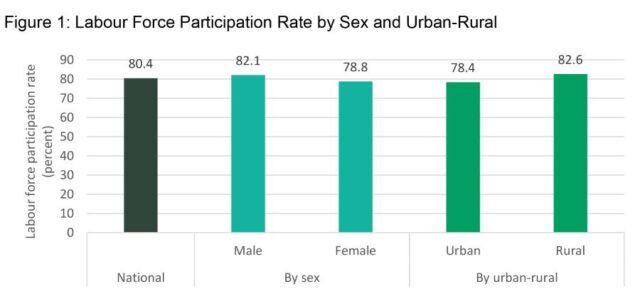FRI, DEC 22 2023-theGBJournal|Nigeria’s registered unemployment rate remains high, rising by 0.1% from the figure recorded in Q1 2023 to 4.2% in Q2 2023, the National Bureau of Statistics data showed on Thursday, in line with analysts expectation.
Focusing on young people, the unemployment rate for 15-24-year-olds was 7.2% in Q2 2023.
In terms of educational attainment, the unemployment rate was 8.0% for those with post secondary education, 5.4% for those with upper secondary education, 3.7% for those with lower secondary education, 3.0% for those with primary education, and 2.5% for those with no formal education.
The statistics office also said that the labour force participation rate (an estimate of the economy’s workforce) in Nigeria was 80.4%, having been 79.9% in Q1 2023.
The Q2 2023 participation rate among men, it said, was 82.1% while for women the participation rate was 78.8%. The participation rate was 78.4% in urban areas and 82.6% in rural areas.
The data shows that 77.1% of Nigeria’s working-age population was in employment while the employment-to-population ratio was 79.3% for men and 74.9% for women respectively.
The employment-to-population ratio in urban areas was 73.8% compared to 80.5% in rural areas.
Meanwhile, in the period under review, 88.0% of employed Nigerians were primarily self-employed with the remaining 12.0% being primarily engaged as employees.
Disaggregation by sex, 85.2% of employed men were self-employed compared to 91.0% of employed women.
Also, 80.5% of employed people in urban areas were self employed compared with 95.3% of employed people in rural areas.
The informal employment rate (the share of employed persons in the informal sector and informal employment) in Q2 2023 was 92.7%.
The NBS data showed that like the previous two quarters, the rate of women in informal employment is higher than that of men.
Although the informality rate is high across all age groups, younger persons (15-24), and persons above 65 years were more informally employed.
The rate of informal employment among people living in rural areas is 97.3% while the urban informality rate is estimated at 88%.
Educational qualification seems to be negatively associated with informality as findings show that persons with higher qualifications are less likely to be in informal employment.
99.6% of people with no formal education were found to be in informal employment.
X-@theGBJournal|Facebook-the Government and Business Journal|email:gbj@govbusinessjournal.com|govandbusinessj@gmail.com










